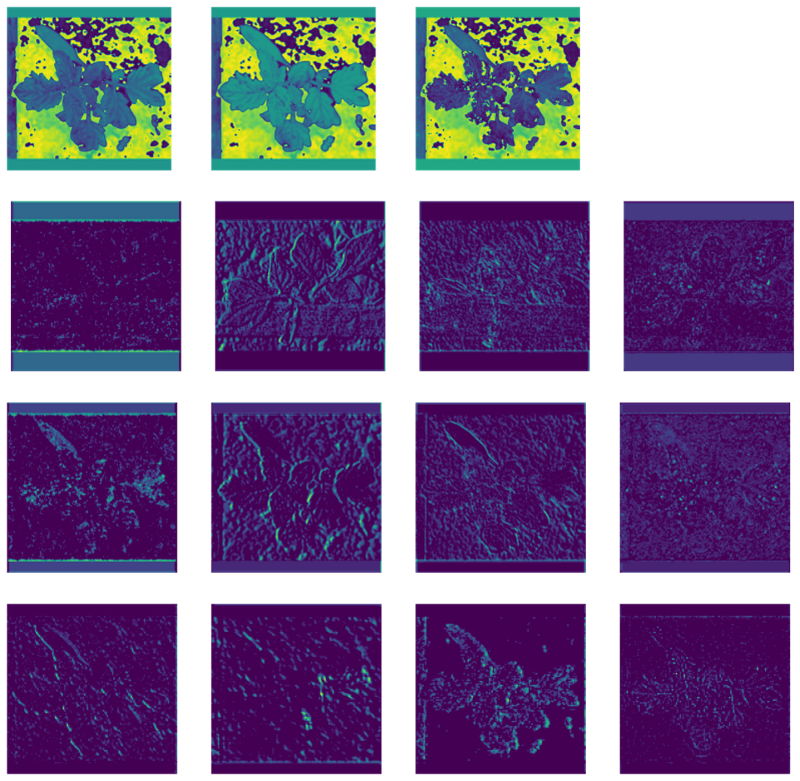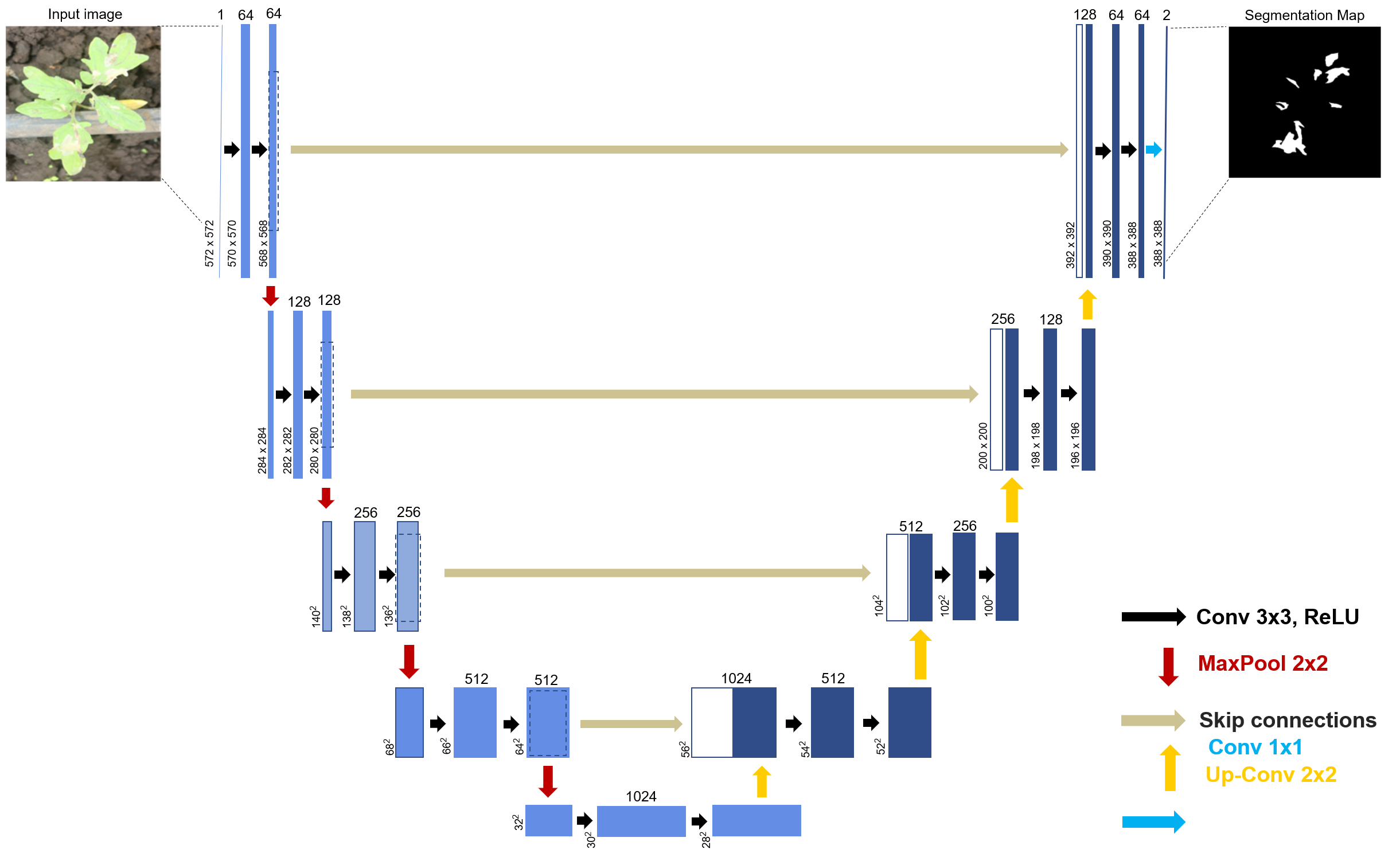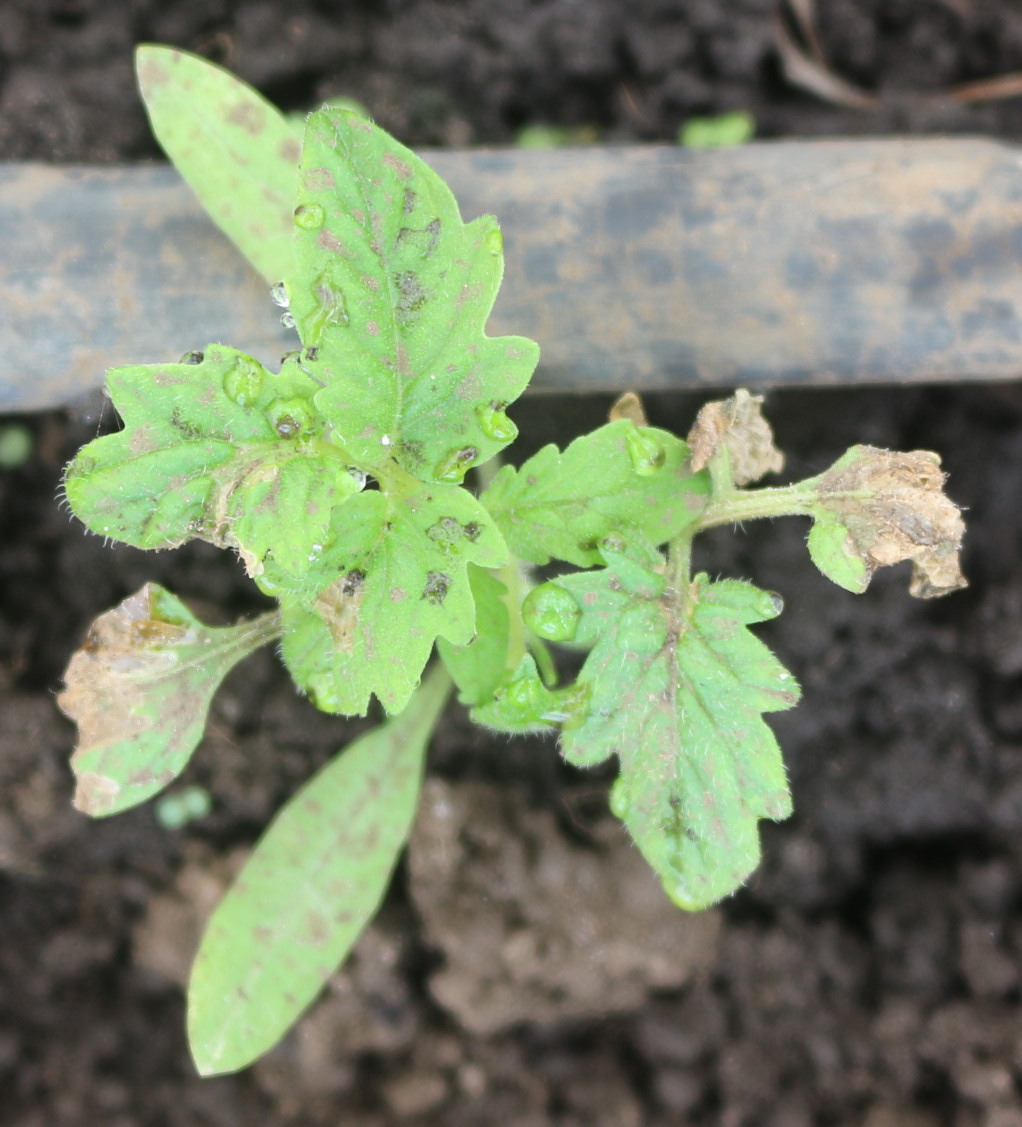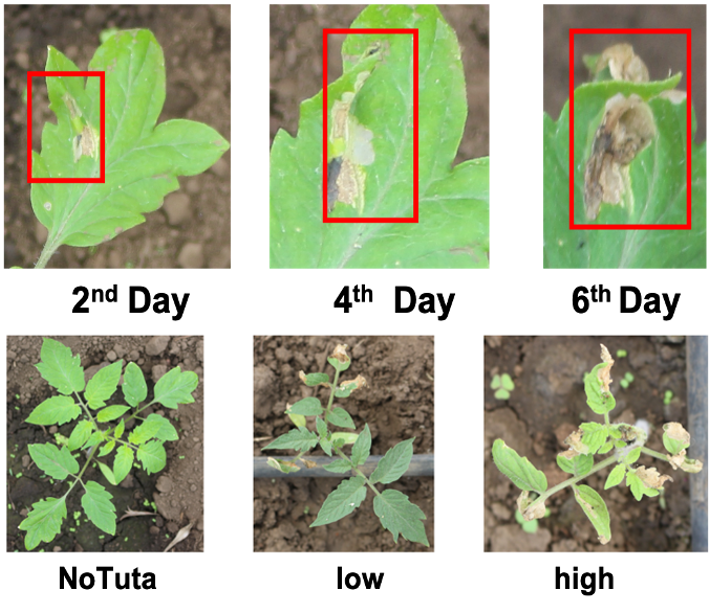Segmentation-based Quantification of Tuta absoluta’s Damage on Tomato Plants
Published in Smart Agricultural Technology - Elsevier, 2024
 The invasion of the tomato leaf miner (Tuta absoluta) poses a significant threat to tomato productivity, leading to substantial yield losses for farmers. Currently, there is a lack of reliable methods for quantifying the effects of Tuta absoluta at an early stage before it causes significant damage. This research proposes a deep Convolutional Neural Network (CNN) model for the segmentation-based quantification of Tuta absoluta on tomato plants. The proposed quantification method employed a Mask RCNN model that achieved a mAP of 85.67 % and precisely detected and segmented the shapes of Tuta absoluta-infected areas on tomato leaves. The ability to accurately detect, segment and count Tuta mines in a tomato leaf image can have a significant impact on the agricultural industry by enabling farmers to quickly assess the extent of damage to their crops and take appropriate measures to prevent further losses.
The invasion of the tomato leaf miner (Tuta absoluta) poses a significant threat to tomato productivity, leading to substantial yield losses for farmers. Currently, there is a lack of reliable methods for quantifying the effects of Tuta absoluta at an early stage before it causes significant damage. This research proposes a deep Convolutional Neural Network (CNN) model for the segmentation-based quantification of Tuta absoluta on tomato plants. The proposed quantification method employed a Mask RCNN model that achieved a mAP of 85.67 % and precisely detected and segmented the shapes of Tuta absoluta-infected areas on tomato leaves. The ability to accurately detect, segment and count Tuta mines in a tomato leaf image can have a significant impact on the agricultural industry by enabling farmers to quickly assess the extent of damage to their crops and take appropriate measures to prevent further losses.
Recommended citation: Loyani, L., (2024). Segmentation-based Quantification of Tuta absoluta’s Damage on Tomato Plants. Smart Agricultural Technology, 7, 100415 https://doi.org/10.1016/J.ATECH.2024.100415

 With the advances in technology, computer vision applications using deep learning methods like Convolutional Neural Networks (CNNs) have been extensively applied in agriculture. Deploying these CNN models on mobile phones is beneficial in making them accessible to everyone, especially farmers and agricultural extension officers. This paper aims to automate the detection of damages caused by a devastating tomato pest known as Tuta Absoluta. To accomplish this objective, a CNN segmentation model trained on a tomato leaf image dataset is deployed on a smartphone application for early and real-time diagnosis of the pest and effective management at early tomato growth stages. The application can precisely detect and segment the shapes of Tuta Absoluta-infected areas on tomato leaves with a minimum confidence of 70% in 5 seconds only.
With the advances in technology, computer vision applications using deep learning methods like Convolutional Neural Networks (CNNs) have been extensively applied in agriculture. Deploying these CNN models on mobile phones is beneficial in making them accessible to everyone, especially farmers and agricultural extension officers. This paper aims to automate the detection of damages caused by a devastating tomato pest known as Tuta Absoluta. To accomplish this objective, a CNN segmentation model trained on a tomato leaf image dataset is deployed on a smartphone application for early and real-time diagnosis of the pest and effective management at early tomato growth stages. The application can precisely detect and segment the shapes of Tuta Absoluta-infected areas on tomato leaves with a minimum confidence of 70% in 5 seconds only. Tuta absoluta is a major threat to tomato production, causing losses ranging from 80% to 100% when not properly managed. Early detection of T. absoluta’s effects on tomato plants is important in controlling and preventing severe pest damage on tomatoes. In this study, we propose semantic and instance segmentation models based on U-Net and Mask RCNN, deep Convolutional Neural Networks (CNN) to segment the effects of T. absoluta on tomato leaf images at pixel level using field data. The results show that Mask RCNN achieved a mean Average Precision of 85.67%, while the U-Net model achieved an Intersection over Union of 78.60% and Dice coefficient of 82.86%. Both models can precisely generate segmentations indicating the exact spots/areas infested by T. absoluta in tomato leaves. The model will help farmers and extension officers make informed decisions to improve tomato productivity and rescue farmers from annual losses.
Tuta absoluta is a major threat to tomato production, causing losses ranging from 80% to 100% when not properly managed. Early detection of T. absoluta’s effects on tomato plants is important in controlling and preventing severe pest damage on tomatoes. In this study, we propose semantic and instance segmentation models based on U-Net and Mask RCNN, deep Convolutional Neural Networks (CNN) to segment the effects of T. absoluta on tomato leaf images at pixel level using field data. The results show that Mask RCNN achieved a mean Average Precision of 85.67%, while the U-Net model achieved an Intersection over Union of 78.60% and Dice coefficient of 82.86%. Both models can precisely generate segmentations indicating the exact spots/areas infested by T. absoluta in tomato leaves. The model will help farmers and extension officers make informed decisions to improve tomato productivity and rescue farmers from annual losses. The images of tomato leafminer (Tuta absoluta) were taken in in-house plots between August 2018 and May 2019 in Arusha, Tanzania. Under net-house that were controlled from other others. T.absoluta larvae were inoculated on the commonly grown tomato varieties at the early growth stage (herein, on the second day after transplanting). The images were taken for the first 2 weeks after inoculation. Images captured the canopy of the plants. It is worth mentioning that dataset contains only Red-Green-Blue (RGB) colored images. The annotated dataset freely available to other researchers through an open access repository to facilitate further research in diagnosing Tuta absoluta’s damage to tomato plants
The images of tomato leafminer (Tuta absoluta) were taken in in-house plots between August 2018 and May 2019 in Arusha, Tanzania. Under net-house that were controlled from other others. T.absoluta larvae were inoculated on the commonly grown tomato varieties at the early growth stage (herein, on the second day after transplanting). The images were taken for the first 2 weeks after inoculation. Images captured the canopy of the plants. It is worth mentioning that dataset contains only Red-Green-Blue (RGB) colored images. The annotated dataset freely available to other researchers through an open access repository to facilitate further research in diagnosing Tuta absoluta’s damage to tomato plants In this study, we propose a Convolutional Neural Network (CNN) approach in determining the effects of Tuta absoluta in tomato plants. Four CNN pre-trained architectures (VGG16, VGG19, ResNet and Inception-V3) were used in training classifiers on a dataset containing health and infested tomato leaves collected from real field experiments. Among the pre-trained architectures, experimental results showed that Inception-V3 yielded the best results with an average accuracy of 87.2 percent in estimating the severity status of Tuta absoluta in tomato plants. The pre-trained models could also easily identify High Tuta severity status compared to other severity status (Low tuta and No tuta)
In this study, we propose a Convolutional Neural Network (CNN) approach in determining the effects of Tuta absoluta in tomato plants. Four CNN pre-trained architectures (VGG16, VGG19, ResNet and Inception-V3) were used in training classifiers on a dataset containing health and infested tomato leaves collected from real field experiments. Among the pre-trained architectures, experimental results showed that Inception-V3 yielded the best results with an average accuracy of 87.2 percent in estimating the severity status of Tuta absoluta in tomato plants. The pre-trained models could also easily identify High Tuta severity status compared to other severity status (Low tuta and No tuta)